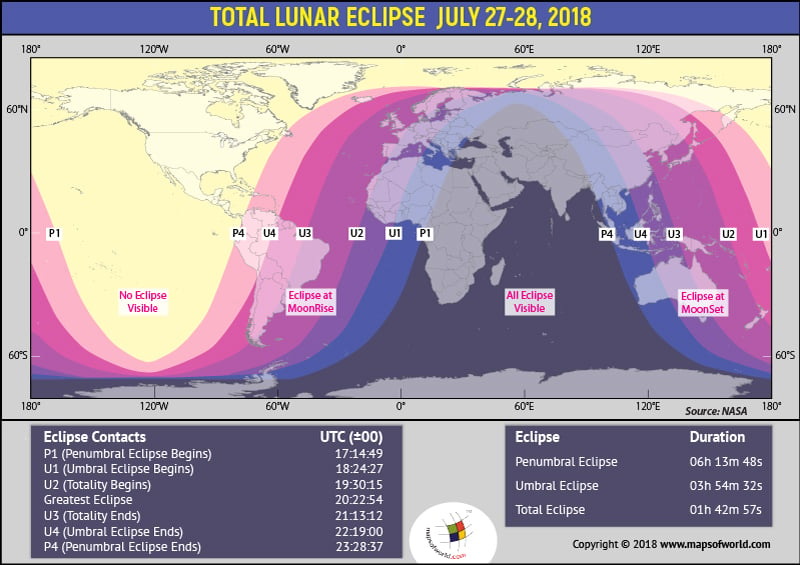When is the century’s longest lunar eclipse?
Eclipse gazers from across the world will witness a phenomenon that is set to dazzle the world. The longest lunar eclipse of the century is set to occur on the evening of Friday, July 27-28th, 2018. This Blood Moon total lunar eclipse will trace a path of totality from parts of Europe, Asia and the Middle East, Australia, and South America.
What happens during a lunar eclipse?
The Earth’s Moon is not irradiant. This means that the moon does not give off light or shine with its own light. It reflects the Sun’s rays that bounce off its surface. When these reflected rays reach the Earth, the moon becomes visible to us.
The Moon also orbits the Earth just as the Earth revolves around the Sun. In the course of these cosmic activities, the Earth sometimes lines up between the Sun and the Moon casting its shadow on the Moon. At times like these the Moon is unable to reflect the Sun’s rays and appears partially or completely dark to the people of the Earth. This celestial event is referred to as a Lunar Eclipse.
During the total lunar eclipse, the Moon enters the umbra or the dark central part of the shadow cast by the Earth on its surface.
What is a Blood Moon?
Blood Moon is not a term used by astronomers but is often used by star gazers and eclipse watchers. A total lunar eclipse is often referred to as a Blood Moon. This is because the Moon starts to take on a reddish tinge during the eclipse. In theory, the Moon (during the eclipse) comes under the Earth’s umbra and should be fully indiscernible against the night sky. But in reality, however, some sunlight reaches the Moon indirectly. The lunar surface receives sunlight that is refracted from the Earth’s atmosphere. This causes the Moon to take on an orange, red, or copper tinge. This is what makes us call the eclipsed Moon a Blood Moon.
What is special about this eclipse?
The total lunar eclipse that is slated to occur on July 27, 2018 is a special one.
• It is the longest total lunar eclipse occurring this century.
• The totality of the eclipse will last for 1 hour and 43 minutes. This is because the Moon is at the farthest distance from the Earth at this time.
• The total duration of the eclipse is 6 hours and 14 minutes.
• The total duration of the partial phases is 2 hours and 12 minutes.
• The magnitude of the upcoming lunar eclipse is 1.609.
• The penumbral magnitude of the upcoming lunar eclipse is 2.679.
Where can I get the best view of the eclipse from?
The Blood Moon eclipse of July 27th 2018 is likely to be visible from many parts of the world. It will be visible to people from South America, Europe, Africa, the Middle East, Asia, and Australia. It will not be visible from North America. India, Sri Lanka, and islands in the Indian Ocean seem best poised to view the total lunar eclipse. The first contact (Penumbral Eclipse) is likely to start at about 22:44:47 hours IST (Hyderabad, India). This will then grow into a total lunar eclipse and the darkest will be at 00:51:44 hours IST (July 28th, 2018) after which it will start decreasing.
How to view the eclipse?
The Blood Moon eclipse is completely safe to look at with the naked eye. Unlike the Solar Eclipse it is unlikely to cause any damage to the eyes and thus there is no need to use protective eye glasses. Avid eclipse watchers and photographers may, however, want to use special lenses or telescopes to be able to view the lunar eclipse and the planet Mars. Eclipse watchers may want to check the cloud cover or pollution levels of their cities on the night of eclipse.
Will the planet Mars be visible during the eclipse?
Those who are keen to watch this unusual celestial phenomenon should also watch out for a very clear view of the planet Mars and other constellations of the Milky Way galaxy. The planet Mars is also likely to be very close to Earth and will appear very clearly without the need for special viewing equipment.
Related Maps:


